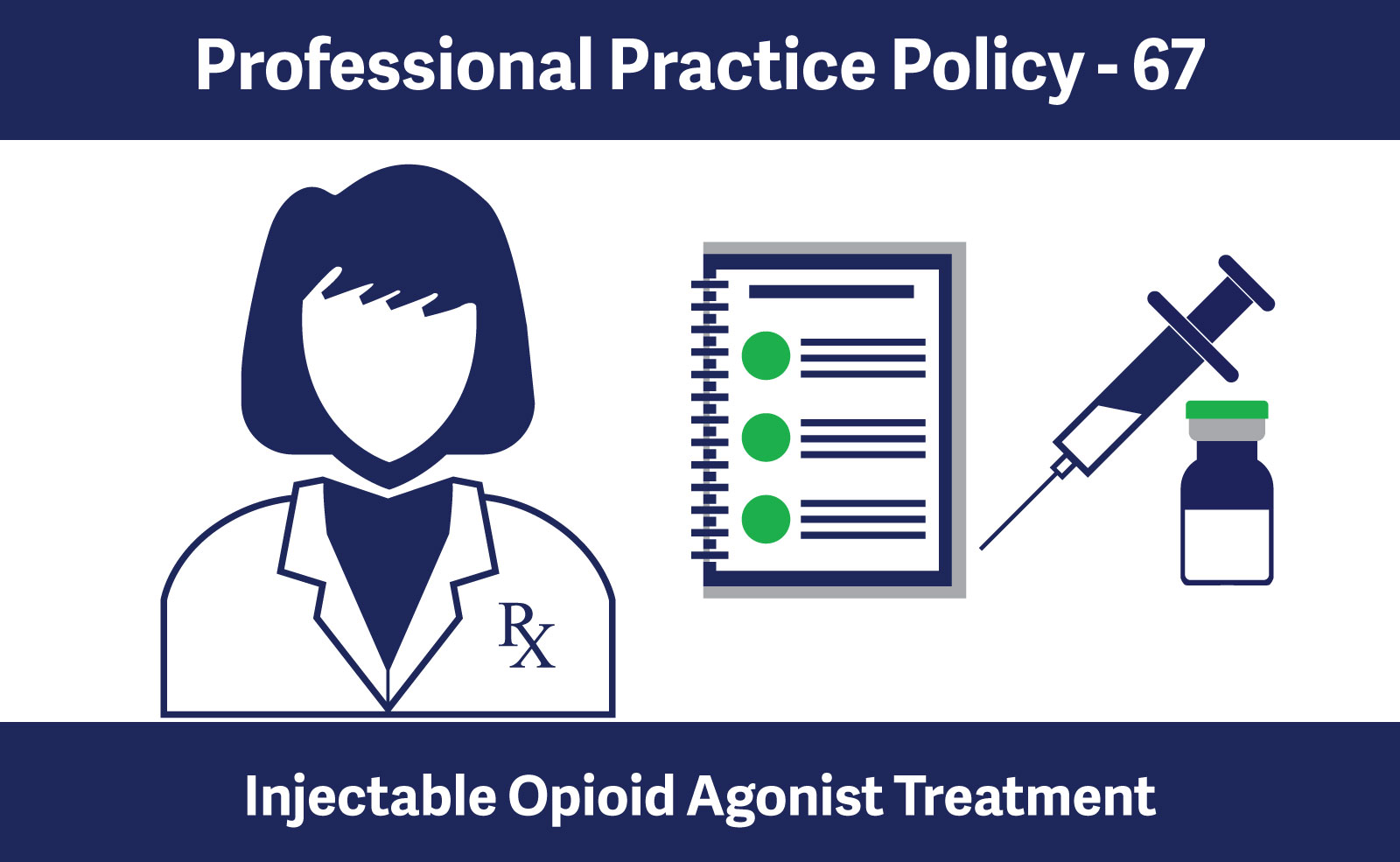New Policy on Injectable Opioid Agonist Treatment (iOAT) Coming Soon
New Professional Practice Policy for Injectable Opioid Agonist Treatment and an accompanying policy guide will come into effect on September 1, 2018.
At its June 2018 meeting, the College Board approved the implementation of Professional Practice Policy-67 for Injectable Opioid Agonist Treatment, as well as an accompanying Policy Guide for Injectable Hydromorphone Maintenance Treatment. These documents set out requirements for the safe dispensing of injectable hydromorphone for the treatment of opioid use disorder.
While the College currently has requirements in place for buprenorphine/naloxone, methadone and slow release oral morphine when used for oral opioid agonist treatment, the College does not yet have specific requirements regarding the dispensing of iOAT drugs. With community pharmacies starting to offer treatments to patients affected by opioid use disorder, including supervised self-injection of hydromorphone, new requirements for the safe dispensing of these drugs is needed to protect patient safety.
The new policy and accompanying guide align with “Guidance for Injectable Opioid Agonist Treatment for Opioid Use Disorder” released by the BC Centre on Substance Use (BCCSU) in October 2017. This document provides recommendations on how injectable opioid agonist treatments can be introduced into clinical practice to reduce harms associated with illicit injection drug use, while also engaging individuals in treatment for substance use disorder.
The BCCSU is a provincially networked organization with a mandate to develop, help implement, and evaluate evidence-based approaches to substance use and addiction. The BCCSU’s “A Guideline for the Clinical Management of Opioid Use Disorder,” was released on June 5, 2017 and provided practice guidance for those involved in the administration of oral opioid agonist treatments (OAT) (i.e. buprenorphine/naloxone, methadone and slow release oral morphine) to treat patients with opioid use disorder.
The BCCSU’s “Guidance for Injectable Opioid Agonist Treatment” was developed to provide treatment options to individuals who have not benefited from oral OAT drugs. These individuals face significant risks, including fatal overdose due in large part to the proliferation of fentanyl and other synthetic analogues into the illicit drug supply.
Oral and Injectable Opioid Agonist TreatmentOpioid agonist treatment is an effective treatment for substance use disorder of opioid drugs such as heroin, oxycodone, fentanyl and Percocet. The treatment involves taking either oral or injectable opioid agonists such as buprenorphine/naloxone, methadone, or slow-release oral morphine, or injectable hydromorphone in order to manage withdrawal and cravings for opioid drugs. These medications have been shown to help people with opioid use disorder stabilize their lives and reduce the harms related to their drug use. |
New Injectable Opioid Agonist Treatment Policy
The College’s new Professional Practice Policy for Injectable Opioid Agonist Treatment sets out requirements for community pharmacies and registrants that provide pharmacist supervision of injectable hydromorphone maintenance treatment.
Professional Practice Policy-67: Injectable Opioid Agonist Treatment
(Effective September 1, 2018)
New Policy Guide for Injectable Hydromorphone Maintenance Treatment
As part of the implementation of Professional Practice Policy-67, the College developed a new policy guide for Injectable Hydromorphone Maintenance Treatment.
The guide outlines required principles and guidelines that must be applied by pharmacy managers, staff pharmacists, relief pharmacists and pharmacy technicians employed in a community pharmacy that provides pharmacist supervision of injectable hydromorphone.
PPP-67 Policy Guide: Injectable Hydromorphone Maintenance Treatment (2018)
(Effective September 1, 2018)
Additional Resources
- Injectable Opioid Agonist Treatment (CPBC)
- Guidance for Injectable Opioid Agonist Treatment for Opioid Use Disorder (BCCSU)
- Opioid Agonist Treatment (CPBC)
- PPP-66 Opioid Agonist Treatment
- PPP-66 Policy Guide: Buprenorphine/Naloxone Maintenance Treatment (2018)
- PPP-66 Policy Guide: Methadone Maintenance Treatment (2013)
- PPP-66 Policy Guide: Slow Release Oral Morphine Maintenance (SROM) Treatment (2018)
- A Guideline for the Clinical Management of Opioid Use Disorder (BCCSU)
- Webinar: Provincial Guidelines for the Clinical Management of Opioid Use Disorder (BCCSU)
- Certification of Practicing Pharmacists for Drug Administration
- Certification in Cardiopulmonary Resuscitation and First Aid
- University of British Columbia Faculty of Medicine, Continuing Professional Development’s, Provincial Opioid Addiction Treatment Support Program
- NAPRA Model Standards for Pharmacy Compounding of Non-hazardous Sterile Preparations
- BC Center for Substance Use Education and Training
- Did you know? Buprenorphine/Naloxone (BCCSU)
- Did you know? Slow-release oral morphine (BCCSU)
- Frequently Asked Questions Buprenorphine/Naloxone Treatment (BCCSU)
- BC Center For Substance Use ReadLinks Series
- How to use Naloxone to Save a Life
- Opioid Agonist Treatment, Opioid overdose crisis, substance use disorder

 Share
Share





